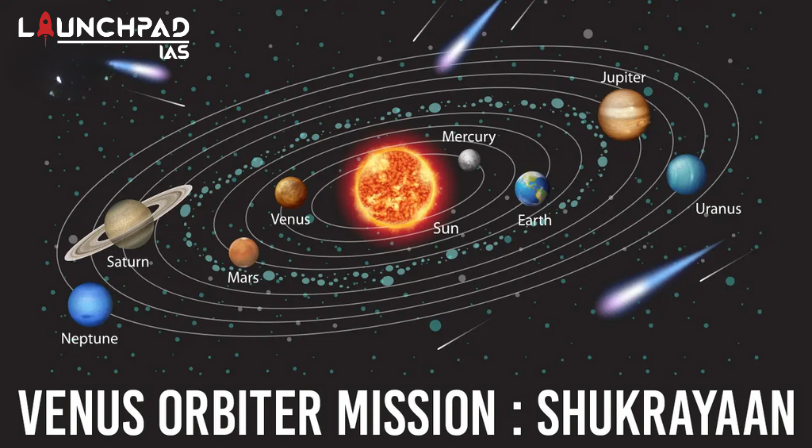About
- Shukrayaan I will be an Orbiter Mission. Its scientific payloads currently include a high-resolution Synthetic Aperture Radar (SAR) and a ground-penetrating radar.
- SAR would examine Venus’ surface, despite the clouds around the planet, which lowers visibility.
- It refers to a technique for producing high-resolution images. Because of its precision, the radar can penetrate clouds and darkness, which means that it can collect data day and night in any weather.
- The Shukrayaan I Mission is expected to study Venus’s geological and volcanic activity, emissions on the ground, wind speed, cloud cover, and other planetary characteristics from an elliptical orbit.
- Shukrayaan I will be launched on either GSLV Mk II or GSLV Mk III, the latter allows more instruments or fuel to be carried, according to ISRO.
Objectives of Shukrayaan I Mission
- Investigation of surface process and shallow subsurface stratigraphy. Until now, no prior observation of the sub-surface of Venus has been done.
- Stratigraphy is a branch of geology in which rock layers and layering are studied.
- Study of the structure, composition, and dynamics of the atmosphere.
- Investigation of Solar wind interaction with Venusian ionosphere.
Significance
- Shukrayaan I Mission will help to learn how Earth-like planets evolve and what conditions exist on Earth-sized exoplanets (Planets that orbit a star other than our sun).
- Shukrayaan I Mission will help in modeling Earth’s climate and serve as a cautionary tale on how dramatically a planet’s climate can change.
Challenges
Landing on the surface of Venus can be a difficult task. The difficulties in landing on Venus are enormous due to its extremely hostile environment. To date, the longest time any spacecraft has spent on the surface is slightly more than two hours, set by the Soviet Union’s Venera 13 probe in 1981.
- Extreme Temperature: The average surface temperature of Venus is more than 460°C, which can easily damage or destroy spacecraft components.
- Crushing Atmospheric Pressure: The atmospheric pressure on Venus’s surface is 90 times greater than on Earth. This can be extremely challenging for any lander or rover to withstand such high pressures.
- Corrosive Sulfuric Acid Rain: Sulfuric acid clouds dominate much of the upper atmosphere above Venus’ surface. These clouds cause intense sulfuric acid rainfalls that can corrode most materials including spacecraft components made from titanium and stainless steel.
- Power Systems: There is a lack of sunlight (due to dense clouds) on Venus that can be used by solar panels. Alternative power systems, such as radioisotope thermoelectric generators (RTGs), have been successfully used in missions by other countries, but they present their challenges in terms of safety and reliability.
- Communication: The thick atmosphere of Venus obstructs communication with mission control on Earth. The planet’s highly reflective clouds also cause signal attenuation, making radio communications difficult for spacecraft.
Other Global Missions to Venus
Future Missions: Several countries have future missions planned to further explore this hostile planet.
- VERITAS: NASA’s next mission is set to launch in 2026. This mission will use radar imaging to map the surface of Venus and study its geology.
- DAVINCI: NASA mission expected by 2026 aims to study Venus’ atmosphere using a descent sphere.
- EnVision: Europe’s space agency ESA is expected to launch it in the 2030s. This orbiter will use radar imaging to create high-resolution maps of Venus’ surface features and provide insights into the planet’s geology.
Facts about planet Venus
- It is named after the Roman goddess of love and beauty. It is the second planet from the Sun and sixth in the solar system in size and mass.
- It is the second brightest natural object in the night sky after the Moon.
- Unlike the other planets in our solar system, Venus and Uranus spin clockwise on their axis.
- It is the hottest planet in the solar system because of the high concentration of carbon dioxide which works to produce an intense greenhouse effect.
- A day on Venus is longer than a year. It takes Venus longer to rotate once on its axis than to complete one orbit of the Sun.
- That’s 243 Earth days to rotate once – the longest rotation of any planet in the Solar System – and only 224.7 Earth days to complete one orbit of the Sun.
- Venus has been called Earth’s twin because of the similarities in their masses, sizes, and densities and their similar relative locations in the solar system.
- No planet approaches closer to Earth than Venus; at its nearest, it is the closest large body to Earth other than the Moon.
- Venus has 90 times the atmospheric pressure of Earth.


